Parent page: Workspace Projects
A Concord Pro Workspace provides an advanced, manufacturing-orientated CAD-centric view of a project when opened in the browser interface. This interface offers Design, Supply, Manufacture, and History view options, available in the left-hand navigation pane:
- Design – Display and navigate source project design documents, view design object properties and place review comments. This view uses the Web Viewer interface to present your design across four distinct data sub-views, to show the source schematic(s), board in 2D and 3D, and the Bill of Materials (BOM) respectively. The Design view is for the latest version of the source project data, rather than a specified release from that project, and so could be considered to be a work-in-progress (WIP) view. You can review both the base design and that of any defined Variant.
- Supply – Interactively examine work-in-progress (WIP) BOM data extracted from the design documents, including entries for Manufacturer and Supplier parts data derived from a project's populated ActiveBOM document.
- Releases – View the releases for the project. Access is provided for opening a specific Release for detailed inspection in a Manufacturing Portal page. From this portal you can view and navigate the released file data, inspect the BOM, and view and comment on the snapshot of the design itself – the source for that released data. From either the Manufacture view, or through the Manufacturing Portal for a specific release, you'll have access to controls for downloading manufacturing data at various levels of granularity (from full data sets to individual generated output files). You also have the ability to compare BOM data between releases.
- History – Browse a progressive timeline of major events relating to the project, including its creation, commits, releases, and clones. Each time a supported event happens in association with the project, that event is added to the timeline as a dedicated tile with various actions supported where applicable. You also can compare BOM data (file download) between release events.
A project is opened from the Workspace's Projects page by double-clicking on the project entry, by a single click on its title, or by selecting the project and choosing the Open option from the  menu or project
menu or project  menu. The page will open in a new browser tab.
menu. The page will open in a new browser tab.
 Accessing the CAD-centric view page for a project.
Accessing the CAD-centric view page for a project.
A project also can be opened in the Workspace's browser interface from within Altium Designer. For the active Workspace project, use the Project » Show in Web Browser command from the main menus. Alternatively, right-click on the entry for the project in the Projects panel and choose the Show in Web Browser command from the context menu.
When browsing the project through Altium Designer's Explorer panel, access to the CAD-centric view page is made by clicking the  button.
button.
The following sections take a closer look at the four views into the project design and its data, as presented in the page for an opened project.
Design
Related page: Web Viewer
The Design view provides interactive visual access to the project's design documents, property data for objects within those documents, and the ability to collaboratively comment on definable document locations. This view is for the latest version of the source project data, rather than a specified release from that project, and so could be considered to be a work-in-progress (WIP) view. You can review both the base design and any available variant of that design.
The Design view also allows you to search, select, cross-probe, and inspect components and nets throughout the design and across the various sub-views as applicable. And when viewing the board in 2D, you can also take measurements.
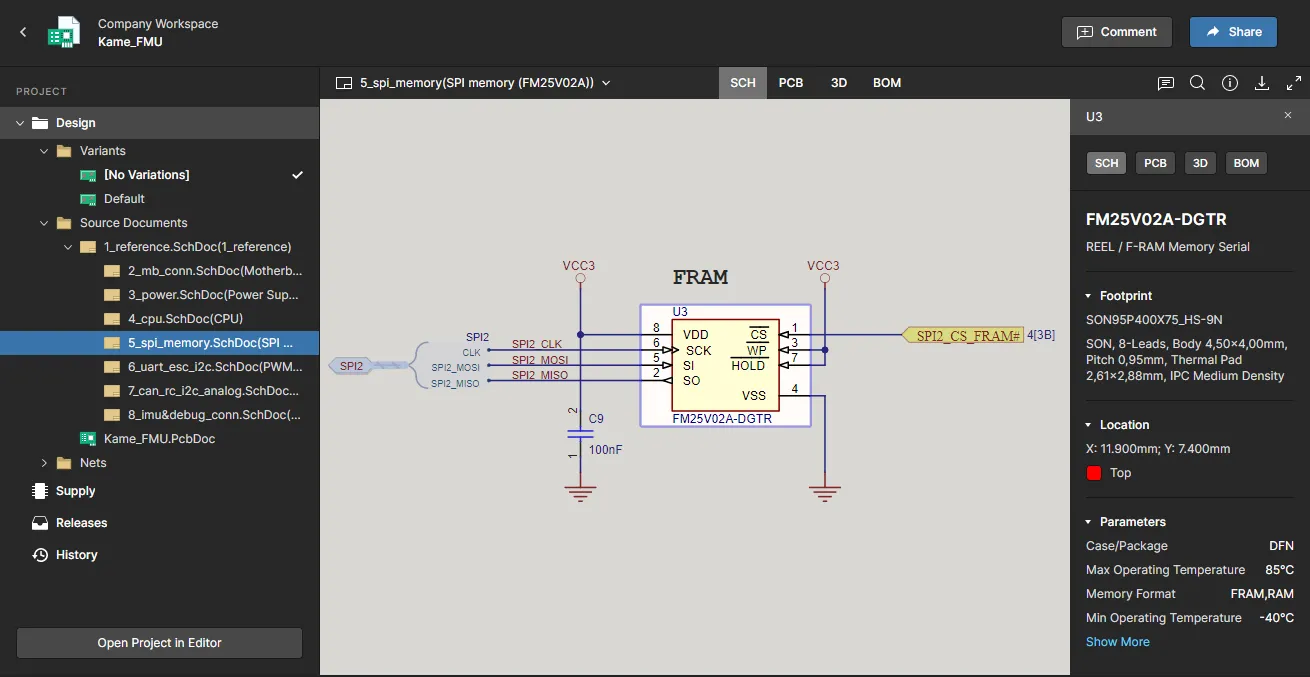
The Design view utilizes Altium's Web Viewer functionality to provide detailed review access the project's source schematic and PCB documents. Shown here is a schematic – hover over the image to see the PCB.
Based on an advanced web graphics engine and interface – Altium's Web Viewer – you are provided with all the features needed to locate and visually inspect the design and its objects. The view also includes fully rendered 2D and 3D PCB layout views, object search and select capabilities, and tree-based design document navigation. Its additional information pane provides an interface to the active Comments system – which dynamically interacts with the design space – and a comprehensive properties listing for any selected design object.
Support is provided for downloading a Zip archive containing a snapshot of the WIP design project (base design), as well as the ability to generate and download a range of derived outputs, which take setup information directly from the applicable Output Job file (where one exists). These include Gerber and NC Drill files, Schematic and Assembly PDFs, and CSV-formatted BOM data.
► See the
Web Viewer page for more information on the Design view functions.
Supply
The Supply view allows you to interactively examine work-in-progress (WIP) BOM data extracted from the design documents. The main grid lists all unique BOM parts ( ) and their main parameters. Select a BOM part entry to view its symbol, footprint and associated properties in the right-hand pane.
) and their main parameters. Select a BOM part entry to view its symbol, footprint and associated properties in the right-hand pane.
 The Supply view enables you to examine the BOM data for the latest version of the source (WIP) project data.
The Supply view enables you to examine the BOM data for the latest version of the source (WIP) project data.
When an ActiveBOM document is part of the design project, each BOM part entry ( ) will include the primary Manufacturer part (
) will include the primary Manufacturer part ( ) and Supplier part (
) and Supplier part ( ) information in a hierarchical view – select an entry to see further details in the side pane.
) information in a hierarchical view – select an entry to see further details in the side pane.
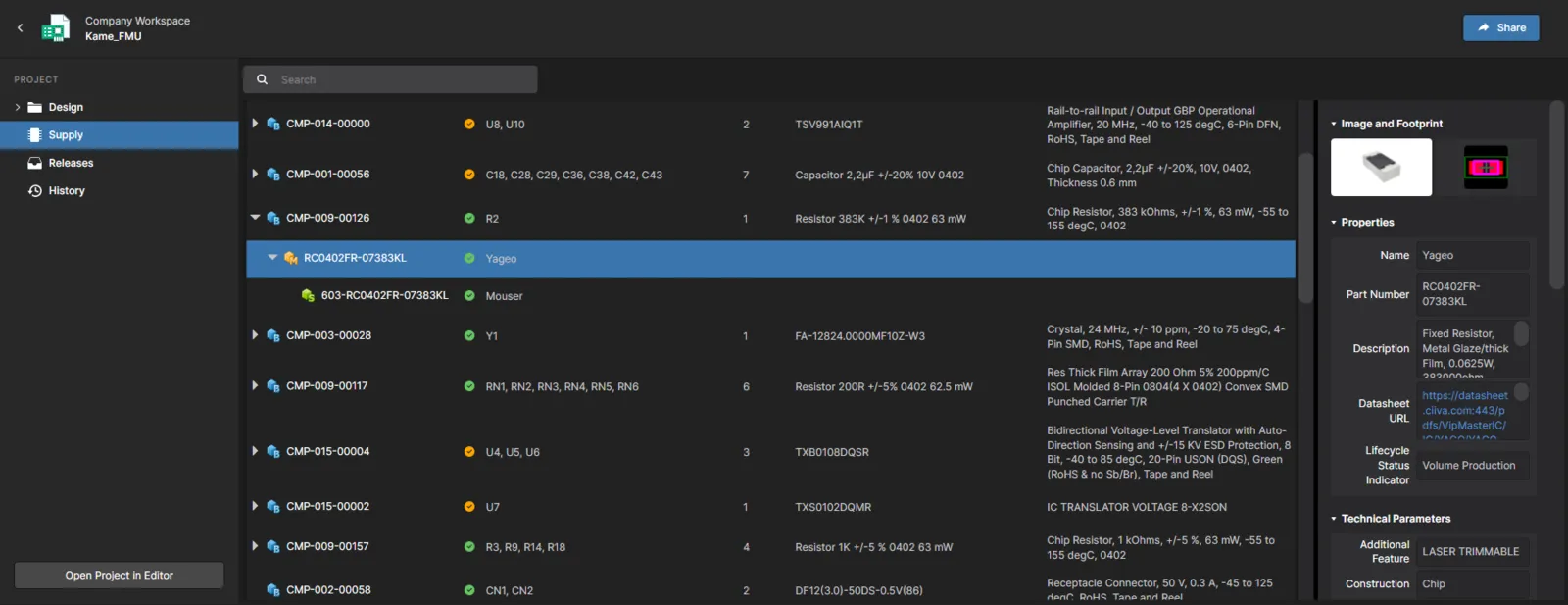
Shown here is the associated information for the selected manufacturer part. Hover over the image to see the information for the selected supplier part.
Use the Search field at the top-left to quickly find an entry of interest. You can search by any of the data columns for the BOM parts, as well as by Manufacturer Name/Part Number and Supplier Name/Part Number. Search is dynamic, with the listing filtered as you type.
When your design uses managed components, the icon associated with a component entry's Designator indicates the revision status of that component:
 – Current (the latest revision of the component is being used).
– Current (the latest revision of the component is being used).
 – Historical (a previous revision of the component, and not the latest, is being used).
– Historical (a previous revision of the component, and not the latest, is being used).
Note that the BOM in this view is for the latest version of the source project data, rather than a specified release from that project.
Projects that do not include part Manufacturer and Supply data (such as when an
ActiveBOM document is not available) show BOM entries and data only.
Releases
The Releases view presents all project release packages that have been generated from the design space (see Releasing a Design), where each package incorporates the released Source, Fabrication and Assembly data.
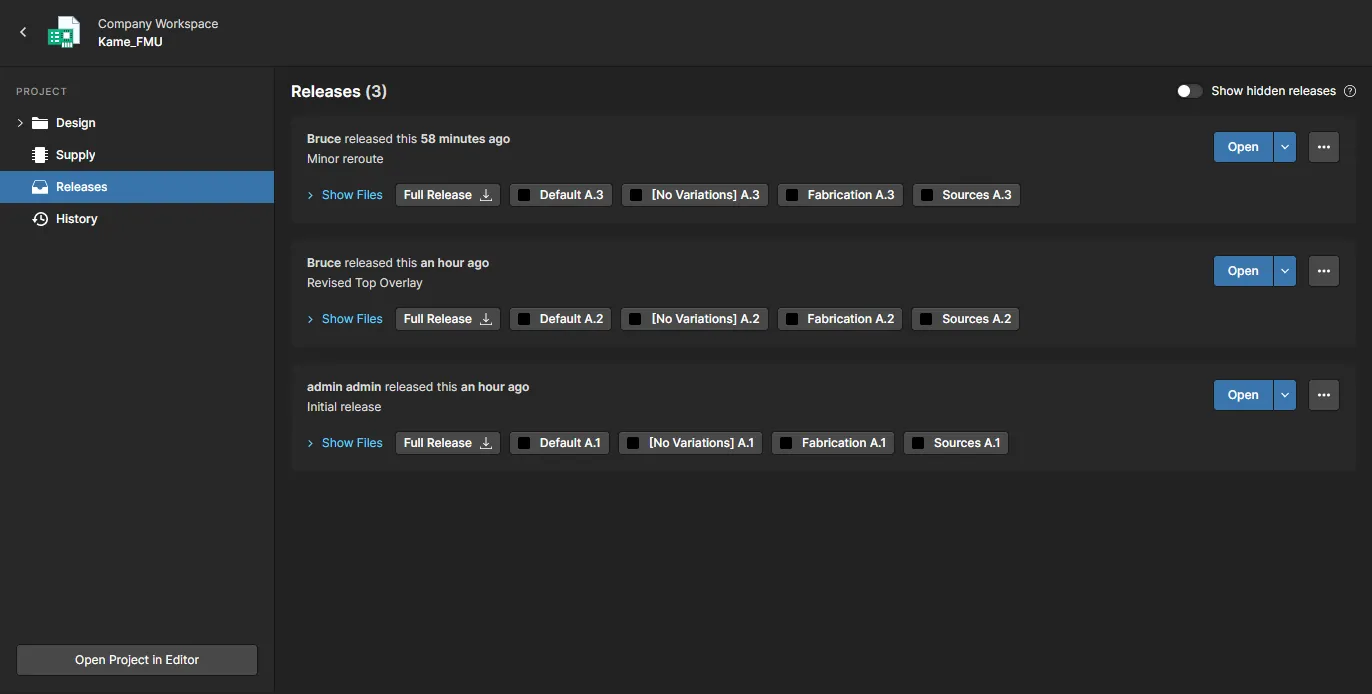
The Releases view gives you access to the released data packages, with the ability to open a package for closer inspection through a dedicated Manufacturing Portal, and also to send a release to your manufacturer as a Manufacturing Package.
From this view you can:
- Download any and all of the data sets included in a release. Click the
 button associated to the release to access a window in which to define which of that release's data sets to download. After clicking the
button associated to the release to access a window in which to define which of that release's data sets to download. After clicking the  button a single Zip archive containing a folder for each included data set will be downloaded to your browser's default downloads folder.
button a single Zip archive containing a folder for each included data set will be downloaded to your browser's default downloads folder.
- Open a release, which will be presented on a separate tab through a Manufacturing Portal. From this portal you can view and navigate the released file data, inspect the BOM, and view and comment on the snapshot of the design itself; the source for that released data. You'll also have access to controls for downloading manufacturing data at various levels of granularity (from full data set(s) to individual generated output file(s)).
- Download BOM Comparison data as a ZIP file.
- Change the lifecycle state for any of the data sets in a release.
- Toggle the display of releases that contain one or more data sets in an inapplicable revision state (e.g., Deprecated, Obsolete, Abandoned states, and where such a state has its Allowed to be used in designs property disabled) using the Show hidden releases control.
The following sections take a closer look at these various features and functionality in closer detail.
Browsing a Release Package
To open the full release package for viewing, click on its associated  button. Alternatively, click the
button. Alternatively, click the  button and choose what to view – either the full release package (Full Release) or a specific assembly (variant). An opened release package is presented in a new Manufacturing Portal browser tab.
button and choose what to view – either the full release package (Full Release) or a specific assembly (variant). An opened release package is presented in a new Manufacturing Portal browser tab.
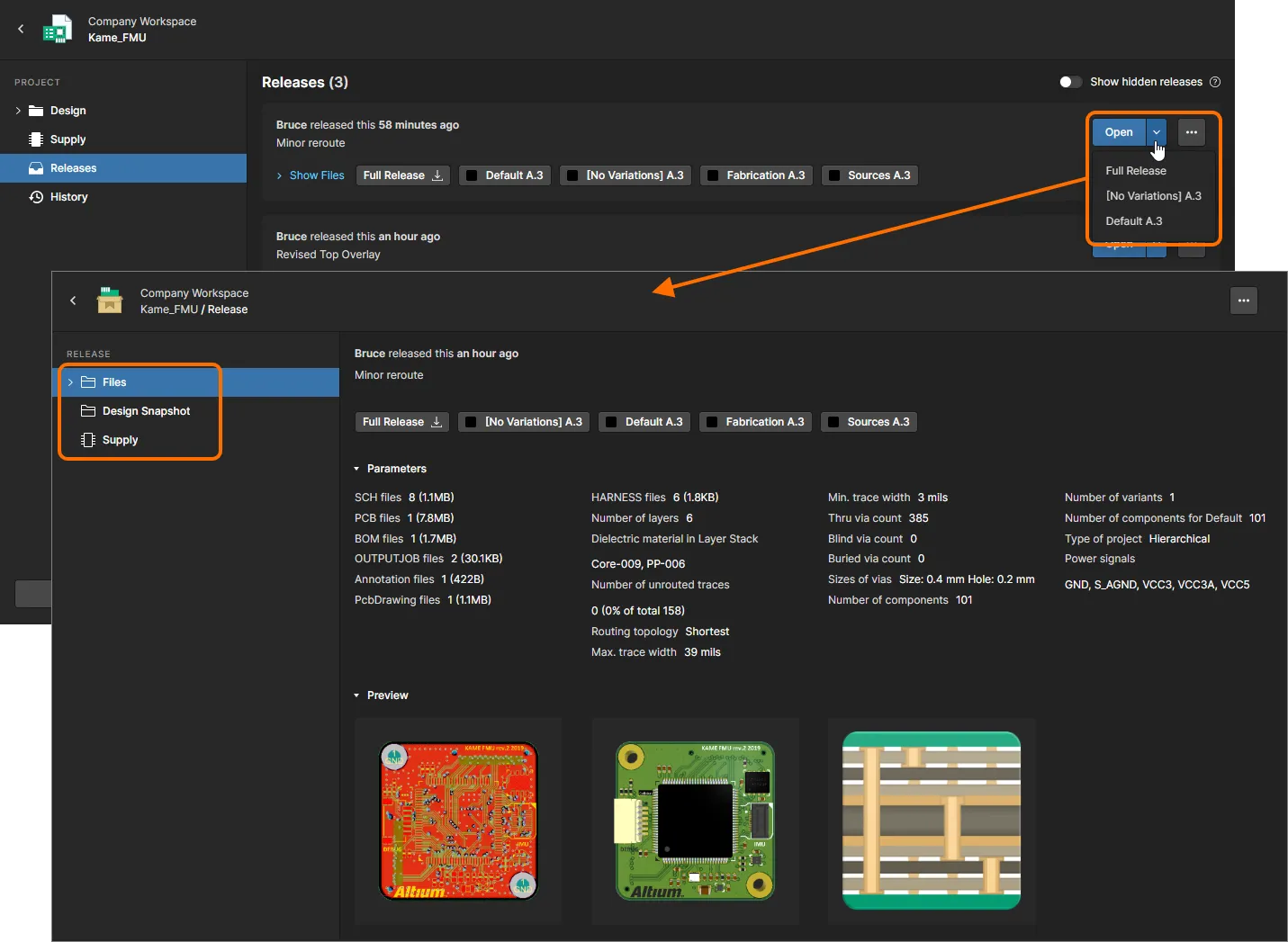
The Manufacture view gives you access to the released data packages, and the ability to open a package for closer inspection through a dedicated Manufacturing Portal.
An opened project release, or a specified variation of it, is presented in a new Manufacturing Portal browser tab and incorporates further sub-views:
Files
The Files view presents an overview of the release package in terms of what data sets it contains (with an indication of their lifecycle states), Workspace-side parameters, a preview of the board in 2D and 3D, and a preview of the board layer stack. The full release package can be downloaded from this page in a single Zip archive (click  ).
).
Expand the tree on the left to view the data sets involved in this release and the data each contains. For the design source, this is the snapshot of the design with all source files used in the release of this particular package. For the fabrication and assembly data sets, this will be the output manufacturing data generated as part of the release. Download is supported at all levels of granularity – from the whole data set, to a particular folder/type of output, down to the individual file level. Hover over an entry and click  the button to start the download, or select an entry and click the
the button to start the download, or select an entry and click the  button within the main viewing area. For a data set or specific folder of output, a Zip archive will be downloaded to your browser's default downloads folder. For an individual file, that file (not zipped) will be downloaded.
button within the main viewing area. For a data set or specific folder of output, a Zip archive will be downloaded to your browser's default downloads folder. For an individual file, that file (not zipped) will be downloaded.
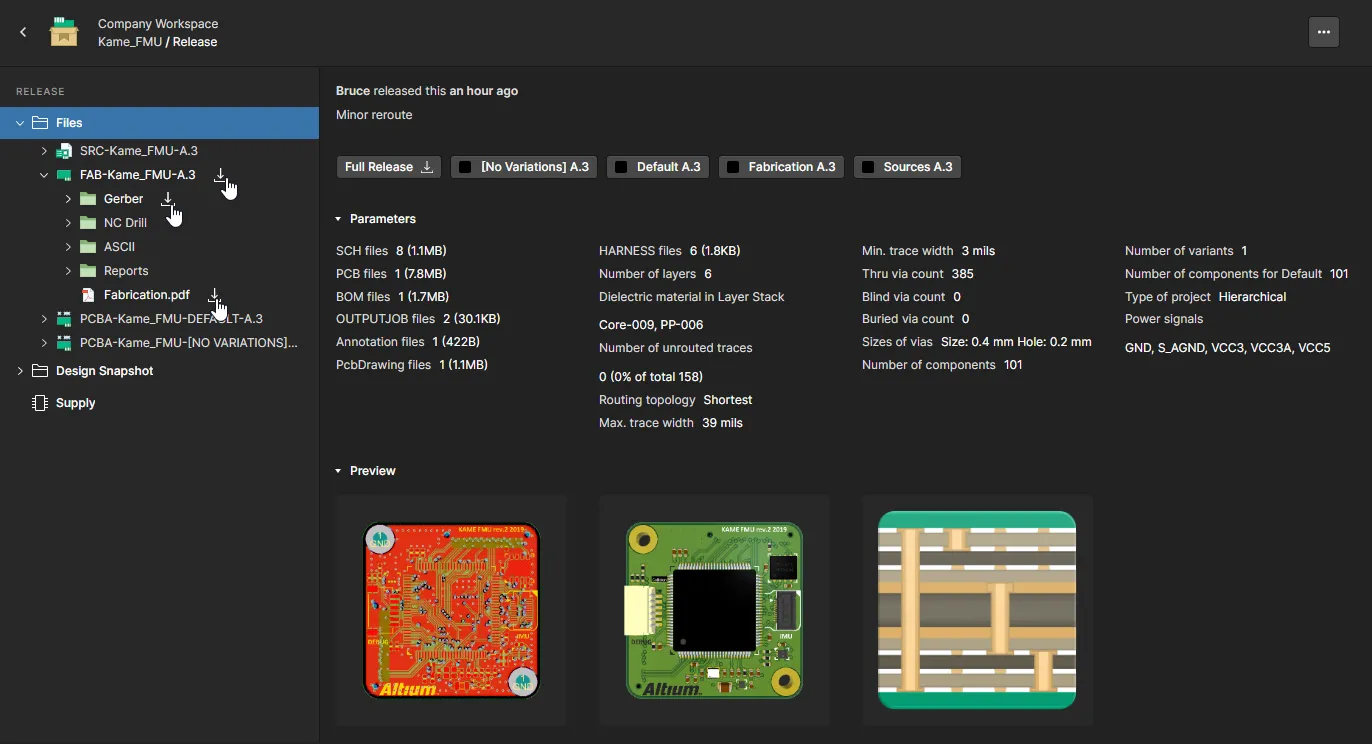
Select any file within the Gerber output list to see a graphical composite of the released Gerber data. Use the Layers menu to view the Gerber data for a specific layer, and the panel options on the upper right to access the Gerber viewer's measurement, commenting and download features.
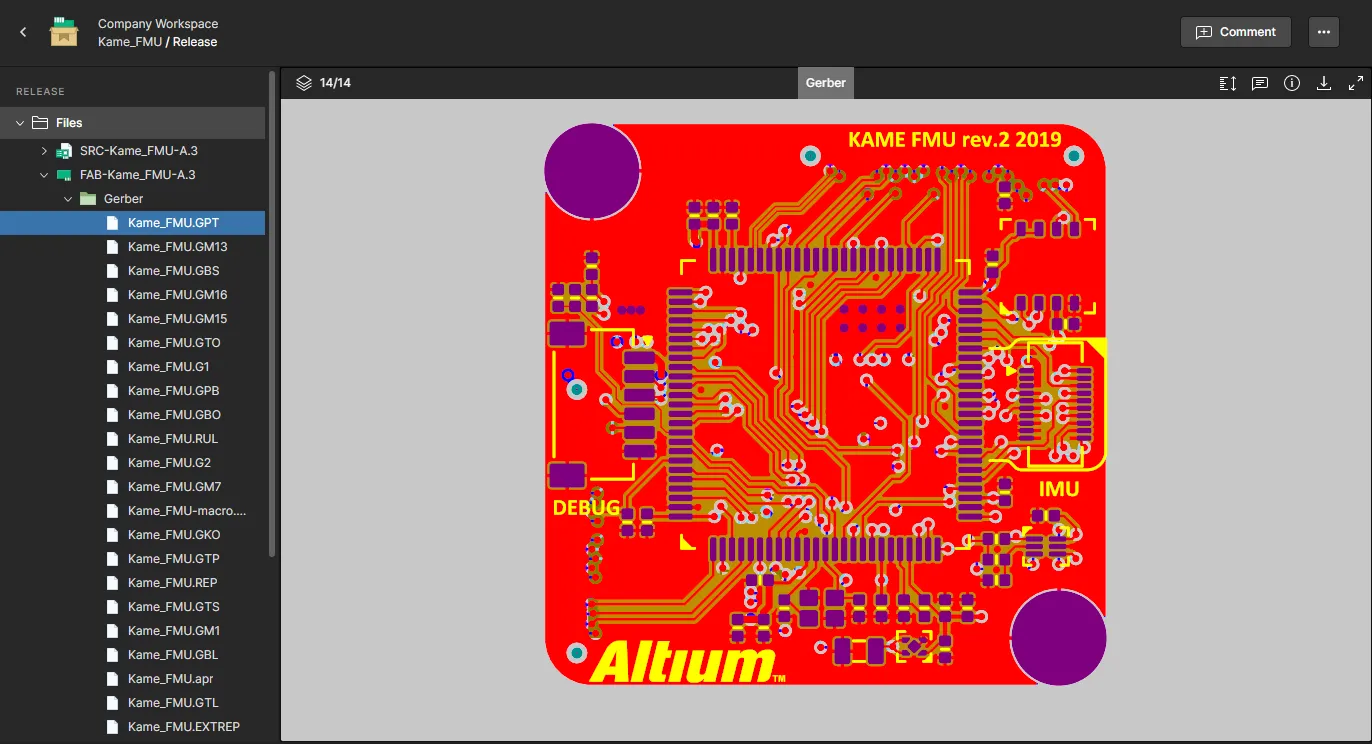
Browsing controls for the Gerber views are as follows:
- Mouse wheel forward/backward to zoom in/out.
- Click & hold (or right-click & hold), then drag to pan document.
Design Snapshot
The Design Snapshot view applies the Web Viewer interface to provide interactive visual access to the design documents, property data for objects within those documents, and the ability to collaboratively comment on definable document locations. Standard review features include PCB layer visibility selection, comment markup, as well as the ability to search, select, and inspect components and nets. You can take measurements in the 2D PCB view.
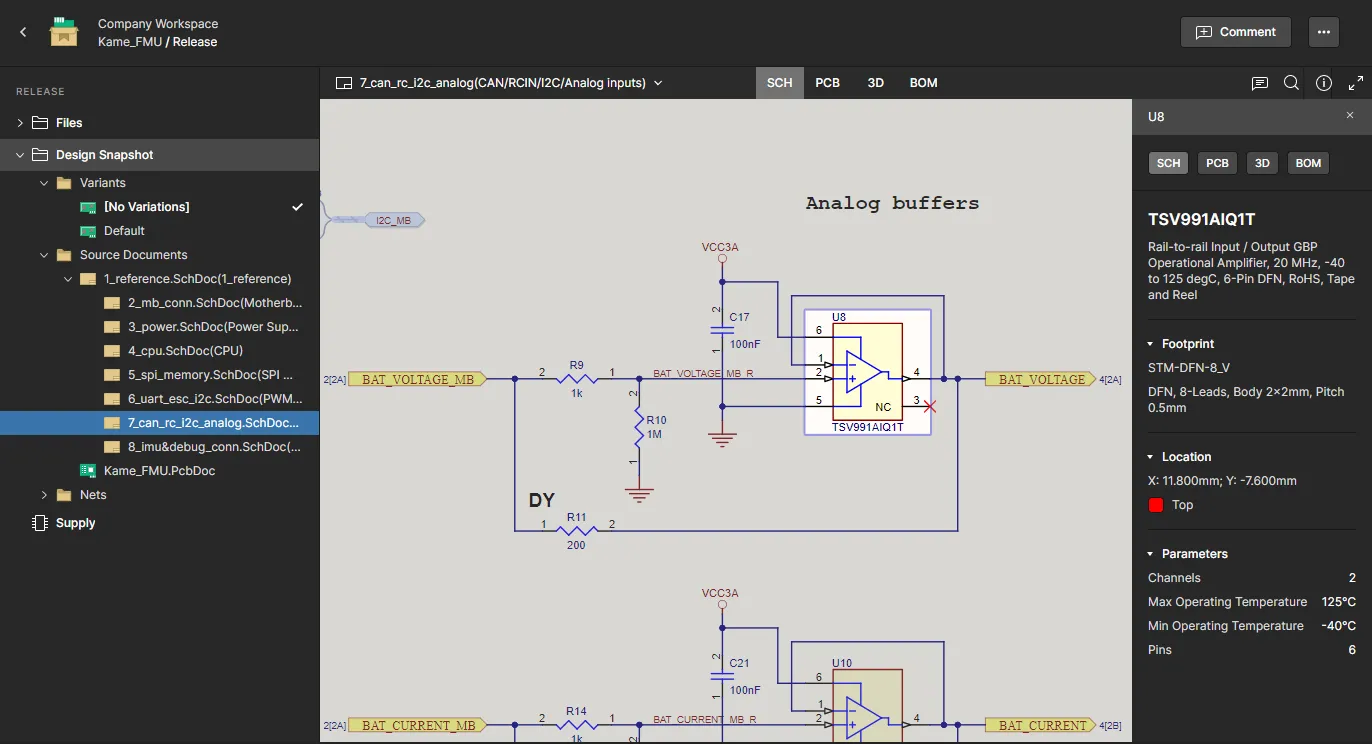
See the
Web Viewer page for more information on the
Design Snapshot view functions.
Supply
The Supply view provides a grid style listing of parts included in the design snapshot used to generate this release package, which when selected populate the right-side information pane with property data for that part. BOM data is extracted from the design source data or an ActiveBOM document if one is included in the project. In the latter case, each BOM part entry ( ) will include the primary Manufacturer part (
) will include the primary Manufacturer part ( ) and Supplier part (
) and Supplier part ( ) information in a hierarchical view, as available from the ActiveBOM document – select an entry to see details in the side pane.
) information in a hierarchical view, as available from the ActiveBOM document – select an entry to see details in the side pane.
All components for the base (non-varied) design are listed.
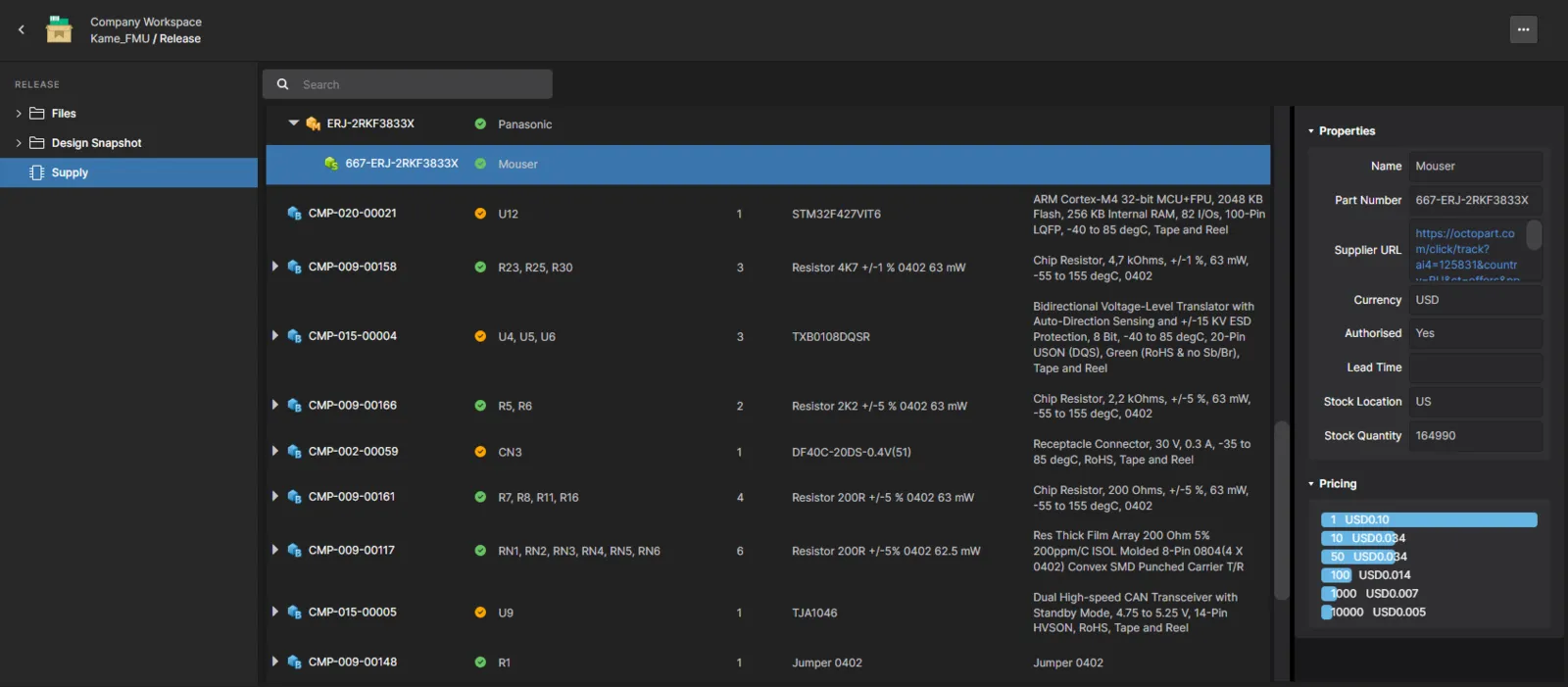
Use the Search field at the top-left of the grid to quickly find an entry of interest. You can search by any of the data columns for the BOM parts, as well as by Manufacturer Name/Part Number and Supplier Name/Part Number. Search is dynamic, with the grid filtered as you type.
In any of the three views, click the  button at the top-right of the view to access controls for changing the lifecycle state of the data sets contained in the release, and also the BOM comparison (BOM To) feature – see below.
button at the top-right of the view to access controls for changing the lifecycle state of the data sets contained in the release, and also the BOM comparison (BOM To) feature – see below.
BOM Comparison
The Bill of Materials (BOM) comparison feature detects differences in raw BOM data between specified project releases. The system will compare the BOM data between the specified project releases and generate a summary of any updates in a standard CSV format. BOM comparison summaries are generated for all available Variants of the design, which are then packaged in a ZIP archive file for downloading. The included CSV file(s) show details of BOM data that has changed – been updated – between the specified project releases.
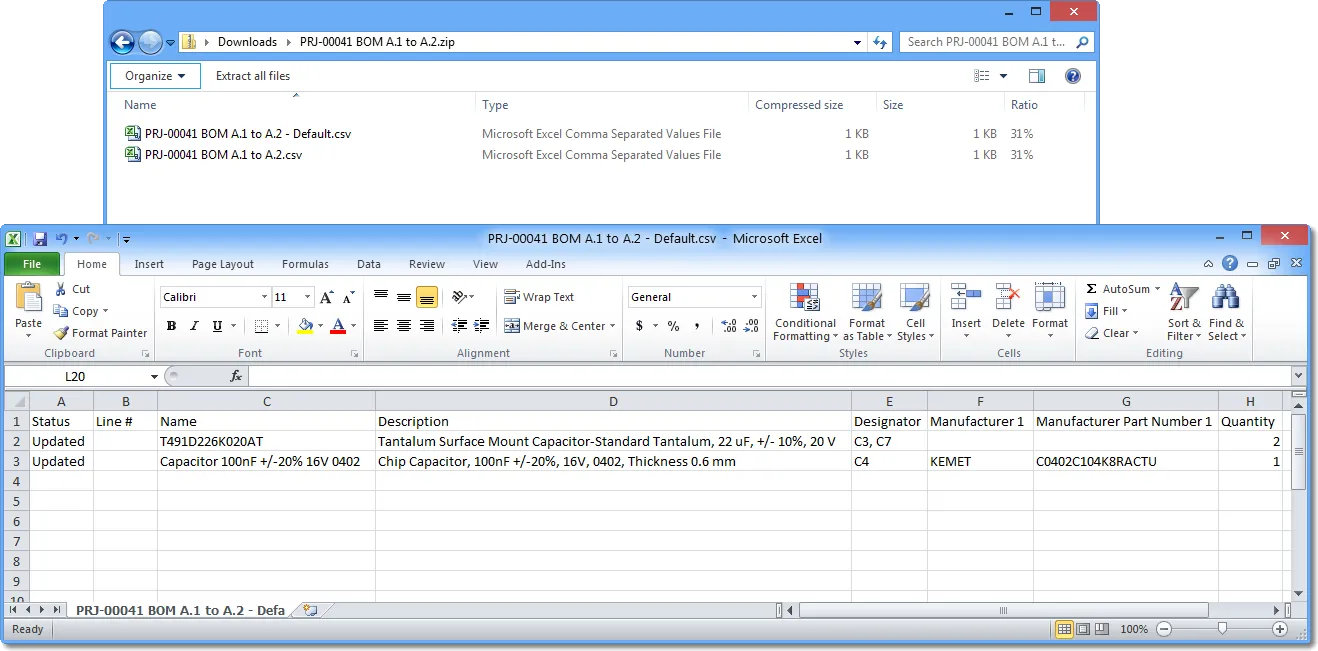
History
Related page: Project History
The History view provides a progressive timeline of major events relating to the project – its creation, commits, releases, clones and MCAD exchanges – with various actions supported where applicable.
 The History view presents a timeline of basic events that have occurred during the project's evolution.
The History view presents a timeline of basic events that have occurred during the project's evolution.
The view can essentially be broken down into three key sections:
- Main trunk of the timeline. The direction of event chronology is from the bottom up. The first event – the creation of the project – will appear at the bottom of the timeline, with subsequent events appear above and the latest (the most current event) appearing at the top.
- Events. Each time a supported event happens in association with the project, that event is added to the timeline as a dedicated tile. Each type of event will have a different colored tile and will either be linked directly to the main trunk of the timeline, or have some additional icon next to it (as is the case for MCAD Exchange events). For Commit events design diffing is supported, showing basic information on what has changed between the current and previous commits (including files, components, nets, PCB structure, variants) – use the
 button to expand the tile view.
button to expand the tile view.
For the following two event types, additional operations are accessible from the event tile:
- Commit event – ability to create a clone of the project using that version of the design, and also the ability to download a snapshot of that version of the design.
- Release event – the ability to open that release package for viewing through a manufacturing portal, and the ability to download either the full release package or the snapshot of the version of the design that was used to create that release package. You can also access the BOM comparison feature. Use the associated sub-menu to compare the BOM data of the release with that of the previous release or select from all releases that have been made for the project.
- Search. Click the
 control at the top-right of the view to access a search field that facilitates basic searching of the project history. As you type your search string, filtering will be applied to the timeline to present only the events relevant to that search.
control at the top-right of the view to access a search field that facilitates basic searching of the project history. As you type your search string, filtering will be applied to the timeline to present only the events relevant to that search.
